A Bibliometric Anatomy of Literature on Bio-Based Fertilisers with Insights into Environmental Impacts and Evaluation Approaches
Abstract
1. Introduction
2. Methodological Approach
2.1. Main Sentence Construction
2.2. Data Collection, Processing and Cleaning
- Document type: Only original (peer-reviewed) papers and reviews. Grey literature was not included.
- Language: Publications entirely written in English were maintained.
- Period: Limited from 2001 to 2024 (the last update was developed on 9 December 2024).
2.3. Bibliometric Analysis
2.4. In-Depth Content Analysis of the Most Influential Publications
3. Results and Discussion
3.1. Descriptive Analysis
3.1.1. Overall Production and Main Information
3.1.2. Subject Areas and Geographical Context
3.1.3. Sources and Authors
3.2. Structures of Knowledge
3.2.1. Conceptual Structure and Thematic Evolution
3.2.2. Authors Publications and Topics That Influence the Scientific Community
3.3. In-Depth Analysis
3.3.1. Studies Using a Non-Life Cycle Assessment (Non-LCA) Approach
3.3.2. Studies Using the Life Cycle Assessment (LCA) Approach
| No | Author/No. of Citations/Source | Country/Region | Technology/Product | Stage(s) | Environmental Concerns | Method of Assessment/ Indicators | Conclusions |
|---|---|---|---|---|---|---|---|
| 1 | Egle [50]/259/ Resources, Conservation and Recycling | Europe | P recovery processes from different sources of wastewater.
| Production | Impacts
| Literature review, information from interviews of plant operators, researchers, and commercial companies, and by visiting existing plants. | Three main approaches for future phosphorus (P) recovery from sewage sludge ash (SSA):
|
| 2 | Riva [57]/146/ Science of the Total Environment | Italy | Untreated cattle slurry, using Anaerobic digestion Products: digestate and separate liquid fraction of digestate. | Production and application (different methods) | Impacts
Soil characteristics did not seem to be affected by fertiliser management in the short term. | Odour emissions [68] Ammonia emissions [69,70] | Results show sub-surface injection of digestate and its derivatives, applied both at pre-sowing and top dressing, achieved crop yields comparable to those obtained with urea. Additionally, this method significantly reduced ammonia emissions to levels similar to urea application. Moreover, the efficient use of digestate, coupled with its high biological stability from the anaerobic process, substantially mitigated odour impact. |
| 3 | Hou [56]/96/Environmental Science and Technology | Europa | The main flows of nutrients embodied in animal manures and the possible manure treatment techniques (the most used in the 27 EU countries).
| Production and application | Impacts
| MITERRA-EUROPE model calculates the nitrogen (N) and phosphorus (P) losses and GHG emissions on a deterministic and annual basis, using statistical data of agriculture at EU country and regional levels [71]. | Anaerobic digestion and solid–liquid separation are the leading manure treatment technologies in Europe. AD is the most effective technology for reducing greenhouse gas (GHG) emissions among all treatment methods. AD and slurry separation have minimal impact on NH3 emissions. Composting is practised on a smaller scale across various EU countries, generally reducing N2O and CH4 emissions compared to traditional storage. Scenario analyses also show alterations in GHG emissions due to manure processing. Technologies like acidification, thermal drying, incineration, and pyrolysis contribute to these changes. Some manure treatment technologies (such as incineration and slow pyrolysis) convert a significant portion of nitrogen (N) to dinitrogen gas, rendering it unusable for fertilisation. |
| 4 | Antonini [49]/87/ Chemosphere | Germany | Six urine-derived struvite fertilisers called MAP: magnesium ammonium phosphate. Five were produced in Germany and one in Vietnam. | Production and application (agronomical performance in a pot trial) | Impact
| Computer modelling to measure the nutrient equivalents (NEQs) and heavy metal fluxes [72]. | The production technology had minimal impact on the final product’s composition, with only a positive correlation between magnesium dosing and magnesium concentration. Struvite from urine collected in Europe and Asia showed no significant dietary effects. GHG tests demonstrated that fertilisers produced comparable or superior biomass yields and phosphorus uptake compared to commercial fertilisers. Environmentally, urine-derived struvite is safe and contributes less heavy metal to soil than other fertilisers, effectively meeting significant portions of crops’ magnesium and phosphorus needs when used with other soil conditioners. |
| 5 | O’Neal [52]/95/ Water Research | USA | Hybrid anion exchange (HAIX) resin containing hydrous ferric oxide. | Production | Impacts
| Phosphate selective resin Equilibrium isotherm models | The HAIX-Fe resin showed a non-linear relationship between solid-phase and solution-phase concentrations for phosphate sorption. Source-separated fresh and hydrolysed urine resulted in higher phosphate recovery and loading on the resin compared to end-of-pipe streams. Diluted urine had lower phosphate loading and required more resin for recovery. This suggests that phosphate recovery is more efficient from building-level wastewater streams compared to central treatment plant effluents. The next step is to develop an LCA for environmental and techno-economic assessment. |
| 6 | Bernstad [55]/87/Waste Management | Sweden | Physical pretreatment of food waste in Sweden: 17 anaerobic digestion plants, four of them were analysed as study cases. | Production | Impacts
| Interviews | Screw press technology resulted in larger losses of biodegradable material and nutrients compared to dispersion technology. There was also a trade-off between higher particle sizes in biomass, which reduce refuse losses but may slow methane conversion. The study highlights an urgent need to improve the efficiency of physical pretreatment processes to enhance methane yield and nutrient recovery from food waste. |
| 7 | He [58]/78/Bioresource Technology | China | Food waste digestate (FWD) and Yard Waste (YW) were mixed for co-Hydrothermal Carbonization (co-HTC) with organic and inorganic catalytic systems | Production of hydrochar as a fuel and the water was used for nutrient recovery (N and P) | Not provided The authors recommend developing an LCA to track the environmental impacts. | Characterisation of hydrochar and process water Thermal analysis for using hydrochar as a fuel | The catalytic co-hydrothermal carbonization (co-HTC) process of food waste digestate (FWD) and yard waste (YW) offers a promising method for bioenergy production and nutrient recovery, contributing to circular economy and carbon neutrality. Inorganic method achieves a high carbon utilisation efficiency of 97.5%. However, further pilot-scale testing is needed to evaluate material flow, energy balance, and environmental impacts to confirm its practicality for commercial use. |
| 8 | Krähenbühl [51]/59/Science of the Total Environment | Nepal | Struvite production from source-separated urine | Production | Impacts
| Calcination with magnesite rocks Struvite characterisation | Magnesite rock is a promising magnesium source for struvite precipitation from source-separated urine in Nepal. Longer calcination times do not improve solubility but increase heating costs. Traditional kilns may lack the precise temperature control needed, but if more controlled kilns are used in Nepal, locally sourced magnesite could be an effective and economical magnesium source for struvite production. |
| 9 | Dong [53]/57/Water Research | USA | Hybrid anion exchangers (HAIX), with doped ferric oxide nanoparticles (FeOnp) for removing phosphates from wastewater | Production | Impacts
| HAIX with a weak acid cation exchanger (WAC) to enrich phosphate and calcium in mild regenerants and precipitate both elements for recovery. Spectroscopic analysis. | The shift from chemical-driven to electricity-driven ion exchange processes could facilitate adoption in remote, decentralised systems. Future work will involve testing this method with real municipal wastewater and exploring more saline water sources to enable chemical-free production of mild acids and bases. The work supports the development of resource-efficient electrochemical regeneration processes and the design of suitable adsorbents for practical applications. |
| 10 | Suleiman [54]/50/Resources, Conservation and Recycling | Netherlands | Microalgae cultivated in wastewater as a biofertiliser | Production and application | Impacts
| Soil sampling Plant productivity and quality GHG sampling (CO2 and N2O fluxes measured in chambers) Molecular analysis Pot test (agronomical performance) | Microalgae from black water serve as an effective biofertiliser, enhancing plant growth. The use of microalgal biofertiliser increases N2O and CO2 emissions, primarily due to nitrification. Different nitrogen sources influence microbial communities in soil and rhizosphere, with plants playing a significant role in shaping microbial populations during growth stages. While microalgal biofertiliser supports nutrient cycling, management practices to reduce nitrification and N2O emissions are crucial for sustainability. Further research is needed to assess potential pathogen risks in these residues. |
| No | Reference/Citation/Source | Country/Region | Technology/Product | Stage | Environmental Concerns Highlighted | Method of Assessment/Indicators | Conclusions |
|---|---|---|---|---|---|---|---|
| 1 | Hospido [62]/189/International Journal of Life Cycle Assessment | Spain | Sludge treatment to obtain agricultural fertilisers through 3 scenarios. Anaerobic digestion Incineration Pyrolysis | Production and land application. | Impacts
| LCA (SimaPro 5.1) Impact categories: Eutrophication, Stratospheric ozone depletion, Global warming, Acidification, Photo-oxidant formation, Depletion of abiotic resources, and Human toxicity. | Further research is needed to determine plant uptake and leaching of heavy metals from sludge in agricultural soils. Efforts to improve valuable by-products and prevent nutrient loss are ongoing. The selection of a sludge management strategy should be site-specific and consider environmental, social, and economic factors for long-term sustainability. Land application of digested sludge is seen as a viable option, but efforts should focus on minimising heavy metal content. |
| 2 | Arashiro [61]/171/Science of the Total Environment | Spain |
| Production and application of digestate as fertiliser. | Impacts
| LCA (SimaPro8)
| HRAP systems coupled with biogas production were found to be more environmentally friendly than those coupled with biofertiliser production across various impact categories. HRAP systems coupled with biofertiliser production were observed to be the most cost-effective alternative for wastewater treatment in small communities, especially when implemented in warm climate regions. |
| 3 | Ishii [66]/150/Water Research | USA | Urine recovery and struvite precipitation A: Baseline B: Urine recovery and struvite precipitation with Magnesium oxide (MgO) C: Urine recovery and struvite precipitation with Magnesium oxide (MgO) + Sodium phosphate (Na3PO4) | Production. | Impacts
| LCA (SimaPro 8.0.3.14 Ecoinvent and USLCI.
| Scenario B showed the smallest environmental impact compared to Scenarios A and C. The economic evaluations found relatively equal costs among the three scenarios. The environmental impact of Scenario A was mainly due to high electricity usage at the centralised wastewater treatment plant. While Scenario C allows for high recoveries of phosphorus and nitrogen as urine-based struvite fertiliser, the manufacturing chemicals required for these precipitation methods have substantial upstream impacts. |
| 4 | Medina-Martos [63]/113/Journal of Cleaner Production | Spain |
| Production | Impacts
| Process modelling and simulation in Aspen Plus®. Techno-economic analysis framework. LCA using Impact Categories recommended by ILCD guidelines: Global warming, Acidification, Respiratory inorganics, Human toxicity cancer effects, and Human toxicity non-cancer effects. | Integrating hydrothermal carbonization (HTC) with anaerobic digestion (AD) enhances energy recovery from sewage sludge (28% vs. 14%) and improves life cycle environmental performance notably reducing global warming impacts from 72 to 18 kg CO2-eq per ton of sludge. Economic challenges, including a 42% higher treatment cost compared to conventional AD. A possible drawback at a policy level is the new trend towards higher nutrient recycling, which may produce legal barriers to hydrochar. |
| 5 | Oldfield [59]/106/Journal of Environmental Management | Belgium, Italy, and Spain |
| Production, crop production (application) and transport. | Impacts
| LCA (GaBi v.6 software)
| Biochar, compost, and biochar–compost blends were found to be environmentally beneficial compared to mineral fertilisers in terms of global warming potential, eutrophication potential, and acidification potential. The study concluded that a one-size-fits-all recommendation cannot be developed for Europe, and site-specific studies are needed continually. All three treatments showed comparative yields to mineral fertiliser, and producing a blended product has the potential as an alternative in climate-smart agriculture. Both approaches showed that biochar, compost, and biochar-compost blend resulted in a cumulative lower environmental impact compared to mineral fertiliser alone. Careful selection of feedstock is crucial for commercial development from a circular economy perspective. |
| 6 | Bisinella de Faria [65]/106/Water Research | Scenario-based on a wastewater treatment plant (WWTP) in East Europa | Urine Source-Separation in five WWTPs scenarios | Production of struvite and agricultural application. | Impacts
| Dynamic Modelling (BioWin®) LCA (Umberto®) Ecoinvent database ReCiPe endpoint methods. | Urine source separation and enhanced primary clarification had positive effects on effluent quality and energy consumption. Nitritation coupled with Anammox for nitrogen removal from urine was identified as an interesting option. Hot spots needing further optimisation were also identified, including infrastructure, N2O emissions, and heavy metals in sludge. |
| 7 | Fang [76]/94/Water Research | Denmark | A wastewater resources recovery technology under development is called TRENS. Water recovery used for fertigation (organic amendment) | Production and application. | Impacts
| LCA using the EASETECH model (DTU, Denmark).
| Key findings include the reduction in impacts by up to 15% for global warming and 9% for marine eutrophication with the TRENS system. Its benefits are limited by the low demand for freshwater substitution and fertiliser. The LCA suggests areas for improvement in construction and operation impacts, contrary to conventional WWTPs focus. The assessment provided feedback to technology developers, highlighting areas for better characterisation and technology evaluation. |
| 8 | Sena [77]/93/Journal of Cleaner Production | USA | Precipitation of struvite from WWTP
| Production |
| LCA (SimaPro 8.5.2.0 coupled with Ecoinvent 3.2) TRACI method midpoint impact factors: Ozone depletion, global warming, smog, acidification, eutrophication, carcinogenic, non-carcinogenic, respiratory effects, ecotoxicity, and fossil fuel depletion. | LCA shows that adding a struvite recovery system at Nine Springs WWTP generally improves the plant’s environmental performance, although the independent impact of the struvite system is neutral. Future research should focus on reducing the environmental impacts of added chemicals, optimising nutrient recovery, and studying the effects of scale and transportation distances on environmental impacts. Recovering phosphorus and nitrogen as a valuable product can reduce the need to mine limited resources like phosphate rock. |
| 9 | Vázquez-Rowe [60]/84/Waste Management | Belgium | Five different digestate treatment systems and a baseline scenario.
| Production, storage, and application. | Impacts
| LCA ReCiPe assessment method Final and midpoints MIXTRI 2.0 model [78]. | Conversion technologies before spreading digestate on fields for fertilisation increased impacts such as global warming and energy use. However, this method has environmental benefits by reducing air emissions (ammonia), resulting in overall environmental gains compared to direct spreading. It is important to assess various impact categories to understand trade-offs between technologies and consider mitigating energy-related impacts by changing energy sources. Future research should focus on dynamic models to assess time-dependent processes and explore nutrient recovery from digestate, as well as conducting consequential LCA to evaluate the broader environmental implications of increased availability of digestate-derived fertilisers as substitutes for chemical fertilisers. |
| 10 | Prapaspongsa [64]/89/Journal of Cleaner Production | Denmark | Twelve scenarios applying various treatment, storage and land application systems | Production and application | Impacts
| LCA Consequential modelling Methods STEPWISE2006 IMPACT2002+ EDIP2003 | The study suggests strategies including integrated treatment technology systems for energy and nutrient recovery and control of emissions at every handling stage. Anaerobic digestion-based scenarios are effective for reducing global warming, while incineration and thermal gasification-based scenarios are effective for minimising ammonia emissions and respiratory inorganics. Uncertainties in ammonia emissions from land application and storage systems were identified through sensitivity analyses. |
4. Concluding Remarks
Supplementary Materials
Author Contributions
Funding
Data Availability Statement
Conflicts of Interest
References
- Lal, R. Soil and Fertilizers Managing the Environmental Footprint, 1st ed.; Lal, R., Ed.; CRC Press: Boca Raton, FL, USA, 2020. [Google Scholar]
- FAO. Inorganic Fertilizers 1961–2019; Food and Agriculture Organization of the United Nations: Rome, Italy, 2021; Available online: https://openknowledge.fao.org/server/api/core/bitstreams/330eec69-3efd-405a-b838-1ec0d005fe6d/content (accessed on 13 October 2025).
- Chojnacka, K.; Mikula, K.; Skrzypczak, D.; Izydorczyk, G.; Gorazda, K.; Kulczycka, J.; Kominko, H.; Moustakas, K.; Witek-Krowiak, A. Practical Aspects of Biowastes Conversion to Fertilizers. Biomass Convers. Biorefinery 2022, 14, 1515–1533. [Google Scholar] [CrossRef]
- Aziz, T.; Maqsood, M.A.; Kanwal, S.; Hussain, S.; Ahmad, H.R.; Sabir, M. Fertilizers and Environment: Issues and Challenges. In Crop Production and Global Environmental Issues; Hakeem, K., Ed.; Springer: Cham, Switzerland, 2015; pp. 575–598. [Google Scholar] [CrossRef]
- Vaneeckhaute, C.; Meers, E.; Michels, E.; Buysse, J.; Tack, F.M.G. Ecological and Economic Benefits of the Application of Bio-Based Mineral Fertilizers in Modern Agriculture. Biomass Bioenergy 2013, 49, 239–248. [Google Scholar] [CrossRef]
- Zhang, Z.; Hou, L.; Qian, Y.; Wan, X. Effect of Zero Growth of Fertilizer Action on Ecological Efficiency of Grain Production in China under the Background of Carbon Emission Reduction. Sustainability 2022, 14, 15362. [Google Scholar] [CrossRef]
- USDA. USDA Announces New Opportunities to Improve Nutrient Management. 2022. Available online: https://www.usda.gov/about-usda/news/press-releases/2022/08/15/usda-announces-new-opportunities-improve-nutrient-management (accessed on 13 October 2025).
- DEFRA. Farm Practices Survey: February 2024—Nutrient Management. Available online: https://www.gov.uk/government/statistics/farm-practices-survey-february-2024/nutrient-management (accessed on 13 October 2025).
- European Commission (EC). Regulation of the European Parliament and of the Council Laying down Rules on the Making Available on the Market of EU Fertilising Products and Amending Regulations (EC) No 1069/2009 and (EC) No 1107/2009 and repealing Regulation (EC) No 2003/2003. Off. J. Eur. Union 2019. Available online: https://eur-lex.europa.eu/legal-content/EN/TXT/?uri=CELEX%3A32019R1009 (accessed on 13 October 2025).
- European Commission (EC). Communication from the Commission to the European Parliament, the Council, the European Economic and Social Committee and the Committee of the Regions: A New Circular Economy Action Plan for a Cleaner and More Competitive Europe; COM(2020) 98 Final; European Commission: Brussels, Belgium, 2020; Available online: https://eur-lex.europa.eu/legal-content/EN/TXT/?uri=CELEX:52020DC0098 (accessed on 13 October 2025).
- European Commission. Farm to Fork Strategy; European Commission: Brussels, Belgium, 2020; Available online: https://food.ec.europa.eu/horizontal-topics/farm-fork-strategy_en (accessed on 13 October 2025).
- European Commission. Pathway to a Healthy Planet for All: EU Action Plan Towards Zero Pollution for Air, Water and Soil; European Commission: Brussels, Belgium, 2021; Available online: https://eur-lex.europa.eu/legal-content/EN/TXT/HTML/?uri=CELEX:52021DC0400 (accessed on 13 October 2025).
- Grizzetti, B.; Vigiak, O.; Aguilera, E.; Aloe, A.; Biganzoli, F.; Billen, G.; Caldeira, C.; De Meij, A.; Egle, L.; Einarsson, R.; et al. Knowledge for Integrated Nutrient Management Action Plan (INMAP); Publications Office of the European Union: Luxembourg, 2023. [Google Scholar] [CrossRef]
- Vaneeckhaute, C.; Ghekiere, G.; Michels, E.; Vanrolleghem, P.A.; Tack, F.M.G.; Meers, E. Assessing Nutrient Use Efficiency and Environmental Pressure of Macronutrients in Biobased Mineral Fertilizers: A Review of Recent Advances and Best Practices at Field Scale. Adv. Agron. 2014, 128, 137–180. [Google Scholar] [CrossRef]
- Chojnacka, K.; Moustakas, K.; Witek-Krowiak, A. Bio-Based Fertilizers: A Practical Approach towards Circular Economy. Bioresour. Technol. 2020, 295, 122223. [Google Scholar] [CrossRef]
- Egas, D.; Azarkamand, S.; Casals, C.; Ponsá, S.; Llenas, L.; Colón, J. Life Cycle Assessment of Bio—Based Fertilizers Production Systems: Where Are We and Where Should We Be Heading? International Life Cycle Data System International Organisation for Standardisation. Int. J. Life Cycle Assess. 2023, 28, 626–650. [Google Scholar] [CrossRef]
- Vaneeckhaute, C. Integrating Resource Recovery Process and Watershed Modelling to Facilitate Decision-Making Regarding Bio-Fertilizer Production and Application. NPJ Clean Water 2021, 4, 15. [Google Scholar] [CrossRef]
- Hendriks, C.M.J.; Shrivastava, V.; Sigurnjak, I.; Lesschen, J.P.; Meers, E.; van Noort, R.; Yang, Z.; Rietra, R.P.J.J. Replacing Mineral Fertilisers for Bio-Based Fertilisers in Potato Growing on Sandy Soil: A Case Study. Appl. Sci. 2022, 12, 341. [Google Scholar] [CrossRef]
- Kvakkestad, V.; Brod, E.; Flø, B.E.; Hanserud, O.; Helgesen, H. Circulation of Nutrients through Bio-Based Fertilizer Products: Perspectives from Farmers, Suppliers, and Civil Society. Front. Sustain. Food Syst. 2023, 7, 1–10. [Google Scholar] [CrossRef]
- Kurniawati, A.; Toth, G.; Ylivainio, K.; Toth, Z. Opportunities and Challenges of Bio—Based Fertilizers Utilization for Improving Soil Health. Org. Agric. 2023, 13, 335–350. [Google Scholar] [CrossRef]
- Zilio, M.; Pigoli, A.; Rizzi, B.; Herrera, A.; Tambone, F.; Geromel, G.; Meers, E.; Schoumans, O.; Giordano, A.; Adani, F. Using Highly Stabilized Digestate and Digestate-Derived Ammonium Sulphate to Replace Synthetic Fertilizers: The Effects on Soil, Environment, and Crop Production. Sci. Total Environ. 2022, 815, 152919. [Google Scholar] [CrossRef]
- Liang, D.; Wang, Y.; Shi, H.; Luo, Z.; Quirino, R.L.; Lu, Q.; Zhang, C. Controllable Release Fertilizer with Low Coating Content Enabled by Superhydrophobic Castor Oil-Based Polyurethane Nanocomposites Prepared through a One-Step Synthetic Strategy. Ind. Crop. Prod. 2022, 189, 115803. [Google Scholar] [CrossRef]
- Tur-Cardona, J.; Bonnichsen, O.; Speelman, S.; Verspecht, A.; Carpentier, L.; Debruyne, L.; Marchand, F.; Jacobsen, B.H.; Buysse, J. Farmers’ Reasons to Accept Bio-Based Fertilizers: A Choice Experiment in Seven Different European Countries. J. Clean. Prod. 2018, 197, 406–416. [Google Scholar] [CrossRef]
- Metson, G.S.; Iwaniec, D.M.; Baker, L.A.; Bennett, E.M.; Childers, D.L.; Cordell, D.; Grimm, N.B.; Grove, J.M.; Nidzgorski, D.A.; White, S. Urban Phosphorus Sustainability: Systemically Incorporating Social, Ecological, and Technological Factors into Phosphorus Flow Analysis. Environ. Sci. Policy 2015, 47, 1–11. [Google Scholar] [CrossRef]
- European Environment Agency (EEA). Bio-Waste in Europe: Turning Challenges into Opportunities; EEA Report No. 04/2020; Publications Office of the European Union: Luxembourg, 2020; Available online: https://www.eea.europa.eu/publications/bio-waste-in-europe (accessed on 13 October 2025).
- Sigurnjak, I.; Brienza, C.; Snauwaert, E.; De Dobbelaere, A.; De Mey, J.; Vaneeckhaute, C.; Michels, E.; Schoumans, O.; Adani, F.; Meers, E. Production and Performance of Bio-Based Mineral Fertilizers from Agricultural Waste Using Ammonia (Stripping-)Scrubbing Technology. Waste Manag. 2019, 89, 265–274. [Google Scholar] [CrossRef] [PubMed]
- Robles-Aguilar, A.A.; Grunert, O.; Meers, E.; Jablonowski, N.D. Evaluating the Fertilising Potential of Blended Recovered Nutrients in Horticultural Growing Medium on Viola x wittrockiana L. Agronomy 2022, 12, 182. [Google Scholar] [CrossRef]
- Albert, S.; Bloem, E. Ecotoxicological Methods to Evaluate the Toxicity of Bio-Based Fertilizer Application to Agricultural Soils—A Review. Sci. Total Environ. 2023, 879, 163076. [Google Scholar] [CrossRef]
- Egene, C.E.; Regelink, I.; Sigurnjak, I.; Adani, F.; Tack, F.M.G.; Meers, E. Greenhouse Gas Emissions from a Sandy Loam Soil Amended with Digestate-Derived Biobased Fertilisers—A Microcosm Study. Appl. Soil Ecol. 2022, 178, 104577. [Google Scholar] [CrossRef]
- Wester-Larsen, L.; Müller-Stöver, D.S.; Salo, T.; Jensen, L.S. Potential Ammonia Volatilization from 39 Different Novel Biobased Fertilizers on the European Market—A Laboratory Study Using 5 European Soils. J. Environ. Manag. 2022, 323, 116249. [Google Scholar] [CrossRef]
- Jensen, L.S.; Oelofse, M.; ten Hoeve, M.; Bruun, S. Environmental Impact Assessment on the Production and Use of Biobased Fertilizers. In Biorefinery of Inorganics; John Wiley & Sons, Ltd.: Hoboken, NJ, USA, 2020; pp. 329–362. [Google Scholar] [CrossRef]
- Hauschild, M.Z.; Rosenbaum, R.K.; Olsen, S.I. Life Cycle Assessment. Theory and Practice; Hauschild, M.Z., Rosenbaum, R.K., Olsen, S.I., Eds.; Springer International Publishing AG: Cham, Switzerland, 2018; Volume 11. [Google Scholar] [CrossRef]
- Curran, M.A. Strengths and Limitations of Life Cycle Assessment. In Background and Future Prospects in Life Cycle Assessment; Klöpffer, W., Ed.; Springer Netherlands: Dordrecht, The Netherlands, 2014; pp. 189–206. [Google Scholar] [CrossRef]
- Martínez-Blanco, J.; Colón, J.; Gabarrell, X.; Font, X.; Sánchez, A.; Artola, A.; Rieradevall, J. The Use of Life Cycle Assessment for the Comparison of Biowaste Composting at Home and Full Scale. Waste Manag. 2010, 30, 983–994. [Google Scholar] [CrossRef]
- Skowroñska, M.; Filipek, T. Life Cycle Assessment of Fertilizers: A Review. Int. Agrophysics 2014, 28, 101–110. [Google Scholar] [CrossRef]
- Bortoluzzi, M.; Correia de Souza, C.; Furlan, M. Bibliometric Analysis of Renewable Energy Types Using Key Performance Indicators and Multicriteria Decision Models. Renew. Sustain. Energy Rev. 2021, 143, 110958. [Google Scholar] [CrossRef]
- Aria, M.; Cuccurullo, C. Bibliometrix: An R-Tool for Comprehensive Science Mapping Analysis. J. Informetr. 2017, 11, 959–975. [Google Scholar] [CrossRef]
- Prashar, A.; Sunder, M.V. A Bibliometric and Content Analysis of Sustainable Development in Small and Medium-Sized Enterprises. J. Clean. Prod. 2020, 245, 118665. [Google Scholar] [CrossRef]
- Wahyuningrum, I.F.S.; Humaira, N.G.; Budihardjo, M.A.; Arumdani, I.S.; Puspita, A.S.; Annisa, A.N.; Sari, A.M.; Djajadikerta, H.G. Environmental Sustainability Disclosure in Asian Countries: Bibliometric and Content Analysis. J. Clean. Prod. 2023, 411, 137195. [Google Scholar] [CrossRef]
- European Commission. Communication from the Commission to the European Parliament, the Council, the European Economic and Social Committee and the Committee of the Regions: Closing the Loop—An EU Action Plan for the Circular Economy; COM(2015) 614 final; European Commission: Brussels, Belgium, 2015; Available online: https://eur-lex.europa.eu/legal-content/EN/TXT/?uri=CELEX:52015DC0614 (accessed on 13 October 2025).
- Aria, M.; Misuraca, M.; Spano, M. Mapping the Evolution of Social Research and Data Science on 30 Years of Social Indicators Research. Soc. Indic. Res. 2020, 149, 803–831. [Google Scholar] [CrossRef]
- Palácios, H.; de Almeida, M.H.; Sousa, M.J. A Bibliometric Analysis of Trust in the Field of Hospitality and Tourism. Int. J. Hosp. Manag. 2021, 95, 102944. [Google Scholar] [CrossRef]
- Amann, A.; Zoboli, O.; Krampe, J.; Rechberger, H.; Zessner, M.; Egle, L. Environmental Impacts of Phosphorus Recovery from Municipal Wastewater. Resour. Conserv. Recycl. 2018, 130, 127–139. [Google Scholar] [CrossRef]
- Bradford-Hartke, Z.; Lane, J.; Lant, P.; Leslie, G. Environmental Benefits and Burdens of Phosphorus Recovery from Municipal Wastewater. Environ. Sci. Technol. 2015, 49, 8611–8622. [Google Scholar] [CrossRef] [PubMed]
- Egle, L.; Rechberger, H.; Krampe, J.; Zessner, M. Phosphorus Recovery from Municipal Wastewater: An Integrated Comparative Technological, Environmental and Economic Assessment of P Recovery Technologies. Sci. Total. Environ. 2016, 571, 522–542. [Google Scholar] [CrossRef] [PubMed]
- Maurer, M.; Pronk, W.; Larsen, T.A. Treatment Processes for Source-Separated Urine. Water Res. 2006, 40, 3151–3166. [Google Scholar] [CrossRef] [PubMed]
- Möller, K.; Müller, T. Effects of Anaerobic Digestion on Digestate Nutrient Availability and Crop Growth: A Review. Eng. Life Sci. 2012, 12, 242–257. [Google Scholar] [CrossRef]
- Vaneeckhaute, C.; Lebuf, V.; Michels, E.; Belia, E.; Vanrolleghem, P.A.; Tack, F.M.G.; Meers, E. Nutrient Recovery from Digestate: Systematic Technology Review and Product Classification. Waste Biomass Valorization 2017, 8, 21–40. [Google Scholar] [CrossRef]
- Antonini, S.; Arias, M.A.; Eichert, T.; Clemens, J. Greenhouse Evaluation and Environmental Impact Assessment of Different Urine-Derived Struvite Fertilizers as Phosphorus Sources for Plants. Chemosphere 2012, 89, 1202–1210. [Google Scholar] [CrossRef]
- Egle, L.; Rechberger, H.; Zessner, M. Overview and Description of Technologies for Recovering Phosphorus from Municipal Wastewater. Resour. Conserv. Recycl. 2015, 105, 325–346. [Google Scholar] [CrossRef]
- Krähenbühl, M.; Etter, B.; Udert, K.M. Pretreated Magnesite as a Source of Low-Cost Magnesium for Producing Struvite from Urine in Nepal. Sci. Total Environ. 2016, 542, 1155–1161. [Google Scholar] [CrossRef]
- O’Neal, J.A.; Boyer, T.H. Phosphate Recovery Using Hybrid Anion Exchange: Applications to Source-Separated Urine and Combined Wastewater Streams. Water Res. 2013, 47, 5003–5017. [Google Scholar] [CrossRef]
- Dong, H.; Wei, L.; Tarpeh, W.A. Electro-Assisted Regeneration of PH-Sensitive Ion Exchangers for Sustainable Phosphate Removal and Recovery. Water Res. 2020, 184, 116167. [Google Scholar] [CrossRef]
- Suleiman, A.K.A.; Lourenço, K.S.; Clark, C.; Luz, R.L.; da Silva, G.H.R.; Vet, L.E.M.; Cantarella, H.; Fernandes, T.V.; Kuramae, E.E. From Toilet to Agriculture: Fertilization with Microalgal Biomass from Wastewater Impacts the Soil and Rhizosphere Active Microbiomes, Greenhouse Gas Emissions and Plant Growth. Resour. Conserv. Recycl. 2020, 161, 104924. [Google Scholar] [CrossRef]
- Bernstad, A.; Malmquist, L.; Truedsson, C.; la Cour Jansen, J. Need for Improvements in Physical Pretreatment of Source-Separated Household Food Waste. Waste Manag. 2013, 33, 746–754. [Google Scholar] [CrossRef]
- Hou, Y.; Velthof, G.L.; Lesschen, J.P.; Staritsky, I.G.; Oenema, O. Nutrient Recovery and Emissions of Ammonia, Nitrous Oxide, and Methane from Animal Manure in Europe: Effects of Manure Treatment Technologies. Environ. Sci. Technol. 2017, 51, 375–383. [Google Scholar] [CrossRef]
- Riva, C.; Orzi, V.; Carozzi, M.; Acutis, M.; Boccasile, G.; Lonati, S.; Tambone, F.; D’Imporzano, G.; Adani, F. Short-Term Experiments in Using Digestate Products as Substitutes for Mineral (N) Fertilizer: Agronomic Performance, Odours, and Ammonia Emission Impacts. Sci. Total Environ. 2016, 547, 206–214. [Google Scholar] [CrossRef]
- He, M.; Zhu, X.; Dutta, S.; Khanal, S.K.; Lee, K.T.; Masek, O.; Tsang, D.C.W. Catalytic Co-Hydrothermal Carbonization of Food Waste Digestate and Yard Waste for Energy Application and Nutrient Recovery. Bioresour. Technol. 2022, 344, 126395. [Google Scholar] [CrossRef]
- Oldfield, T.L.; Sikirica, N.; Mondini, C.; López, G.; Kuikman, P.J.; Holden, N.M. Biochar, Compost and Biochar-Compost Blend as Options to Recover Nutrients and Sequester Carbon. J. Environ. Manag. 2018, 218, 465–476. [Google Scholar] [CrossRef]
- Vázquez-Rowe, I.; Golkowska, K.; Lebuf, V.; Vaneeckhaute, C.; Michels, E.; Meers, E.; Benetto, E.; Koster, D. Environmental Assessment of Digestate Treatment Technologies Using LCA Methodology. Waste Manag. 2015, 43, 442–459. [Google Scholar] [CrossRef]
- Arashiro, L.T.; Montero, N.; Ferrer, I.; Acién, F.G.; Gómez, C.; Garfí, M. Life Cycle Assessment of High Rate Algal Ponds for Wastewater Treatment and Resource Recovery. Sci. Total Environ. 2018, 622–623, 1118–1130. [Google Scholar] [CrossRef]
- Hospido, A.; Moreira, T.; Martín, M.; Rigola, M.; Feijoo, G. Environmental Evaluation of Different Treatment Processes for Sludge from Urban Wastewater Treatments: Anaerobic Digestion versus Thermal Processes. Int. J. Life Cycle Assess. 2005, 10, 336–345. [Google Scholar] [CrossRef]
- Medina-Martos, E.; Istrate, I.-R.; Villamil, J.A.; Gálvez-Martos, J.-L.; Dufour, J.; Mohedano, Á.F. Techno-Economic and Life Cycle Assessment of an Integrated Hydrothermal Carbonization System for Sewage Sludge. J. Clean. Prod. 2020, 277, 122930. [Google Scholar] [CrossRef]
- Prapaspongsa, T.; Christensen, P.; Schmidt, J.H.; Thrane, M. LCA of Comprehensive Pig Manure Management Incorporating Integrated Technology Systems. J. Clean. Prod. 2010, 18, 1413–1422. [Google Scholar] [CrossRef]
- Bisinella de Faria, A.B.; Spérandio, M.; Ahmadi, A.; Tiruta-Barna, L. Evaluation of New Alternatives in Wastewater Treatment Plants Based on Dynamic Modelling and Life Cycle Assessment (DM-LCA). Water Res. 2015, 84, 99–111. [Google Scholar] [CrossRef]
- Ishii, S.K.L.; Boyer, T.H. Life Cycle Comparison of Centralized Wastewater Treatment and Urine Source Separation with Struvite Precipitation: Focus on Urine Nutrient Management. Water Res. 2015, 79, 88–103. [Google Scholar] [CrossRef]
- Elgarahy, A.M.; Eloffy, M.G.; Alengebawy, A.; El-Sherif, D.M.; Gaballah, M.S.; Elwakeel, K.Z.; El-Qelish, M. Sustainable Management of Food Waste; Pre-Treatment Strategies, Techno-Economic Assessment, Bibliometric Analysis, and Potential Utilizations: A Systematic Review. Environ. Res. 2023, 225, 115558. [Google Scholar] [CrossRef]
- Orzi, V.; Scaglia, B.; Lonati, S.; Riva, C.; Boccasile, G.; Alborali, G.L.; Adani, F. The Role of Biological Processes in Reducing Both Odor Impact and Pathogen Content during Mesophilic Anaerobic Digestion. Sci. Total Environ. 2015, 526, 116–126. [Google Scholar] [CrossRef]
- Flesch, T.K.; Wilson, J.D.; Yee, E. Backward-Time Lagrangian Stochastic Dispersion Models and Their Application to Estimate Gaseous Emissions. J. Appl. Meteorol. 1995, 34, 1320–1332. [Google Scholar] [CrossRef]
- Loubet, B.; Milford, C.; Sutton, M.A.; Cellier, P. Investigation of the Interaction between Sources and Sinks of Atmospheric Ammonia in an Upland Landscape Using a Simplified Dispersion–Exchange Model. J. Geophys. Res. 2001, 106, 24183–24195. [Google Scholar] [CrossRef]
- Velthof, G.L.; Oudendag, D.; Witzke, H.P.; Asman, W.A.H.; Klimont, Z.; Oenema, O. Integrated Assessment of Nitrogen Losses from Agriculture in EU-27 Using MITERRA-EUROPE. J. Environ. Qual. 2009, 38, 402–417. [Google Scholar] [CrossRef] [PubMed]
- Hammer, M.; Clemens, J. A Tool to Evaluate the Fertiliser Value and the Environmental Impact of Substrates from Wastewater Treatment. Water Sci. Technol. 2007, 56(5), 201–209. [Google Scholar] [CrossRef]
- Bare, J.C.; Norris, G.A.; Pennington, D.W.; McKone, T. Tool for the Reduction and Assessment of Chemical and Other Environmental Impacts (TRACI), Version 2.1 – User’s Manual; U.S. EPA Office of Research and Development: Washington, DC, USA, 2014; EPA/600/R-12/554. [Google Scholar]
- Guinée, J.B.; Gorrée, M.; Heijungs, R.; Huppes, G.; Kleijn, R.; de Koning, A.; van Oers, L.; Wegener Sleeswijk, A.; Suh, S.; Udo de Haes, H.A.; et al. Handbook on Life Cycle Assessment: Operational Guide to the ISO Standards; Kluwer Academic Publishers: Dordrecht, The Netherlands, 2002. [Google Scholar] [CrossRef]
- ISO 14040; Environmental Management—Life Cycle Assessment—Principles and Framework. International Organization for Standardization: Geneva, Switzerland, 2006.
- Fang, L.L.; Valverde-Pérez, B.; Damgaard, A.; Plósz, B.G.; Rygaard, M. Life Cycle Assessment as Development and Decision Support Tool for Wastewater Resource Recovery Technology. Water Res. 2016, 88, 538–549. [Google Scholar] [CrossRef]
- Sena, M.; Seib, M.; Noguera, D.R.; Hicks, A. Environmental Impacts of Phosphorus Recovery through Struvite Precipitation in Wastewater Treatment. J. Clean. Prod. 2021, 280, 124222. [Google Scholar] [CrossRef]
- Doka, G. MIXTRI 2.0 – an MS Excel 97 VBA Macro to Draw LCA Results in a Mixing Triangle (aka ternary plot). 2.0 ed. Zurich. 2011. Available online: http://www.doka.ch/EI99/mixtri.htm (accessed on 13 October 2025).
- Gaffey, J.; Collins, M.N.; Styles, D. Review of Methodological Decisions in Life Cycle Assessment (LCA) of Biorefinery Systems across Feedstock Categories. J. Environ. Manag. 2024, 358, 120813. [Google Scholar] [CrossRef]
- European Commission; EJoint Research Centre (JRC); Institute for Environment and Sustainability (IES). International Reference Life Cycle Data System (ILCD) Handbook—General Guide for Life Cycle Assessment—Detailed Guidance, 1st ed.; Publications Office of the European Union: Luxembourg, 2010. [Google Scholar] [CrossRef]
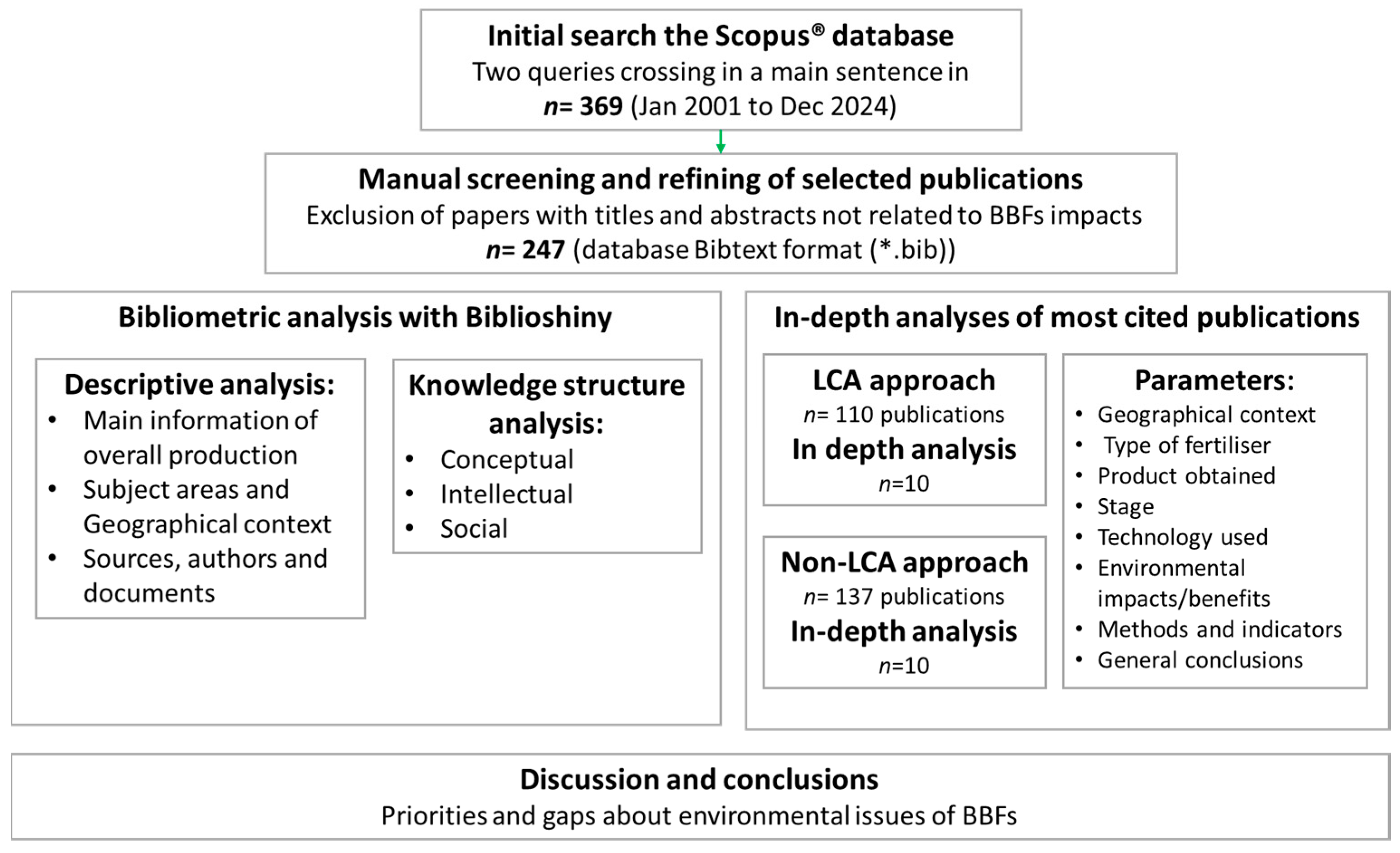
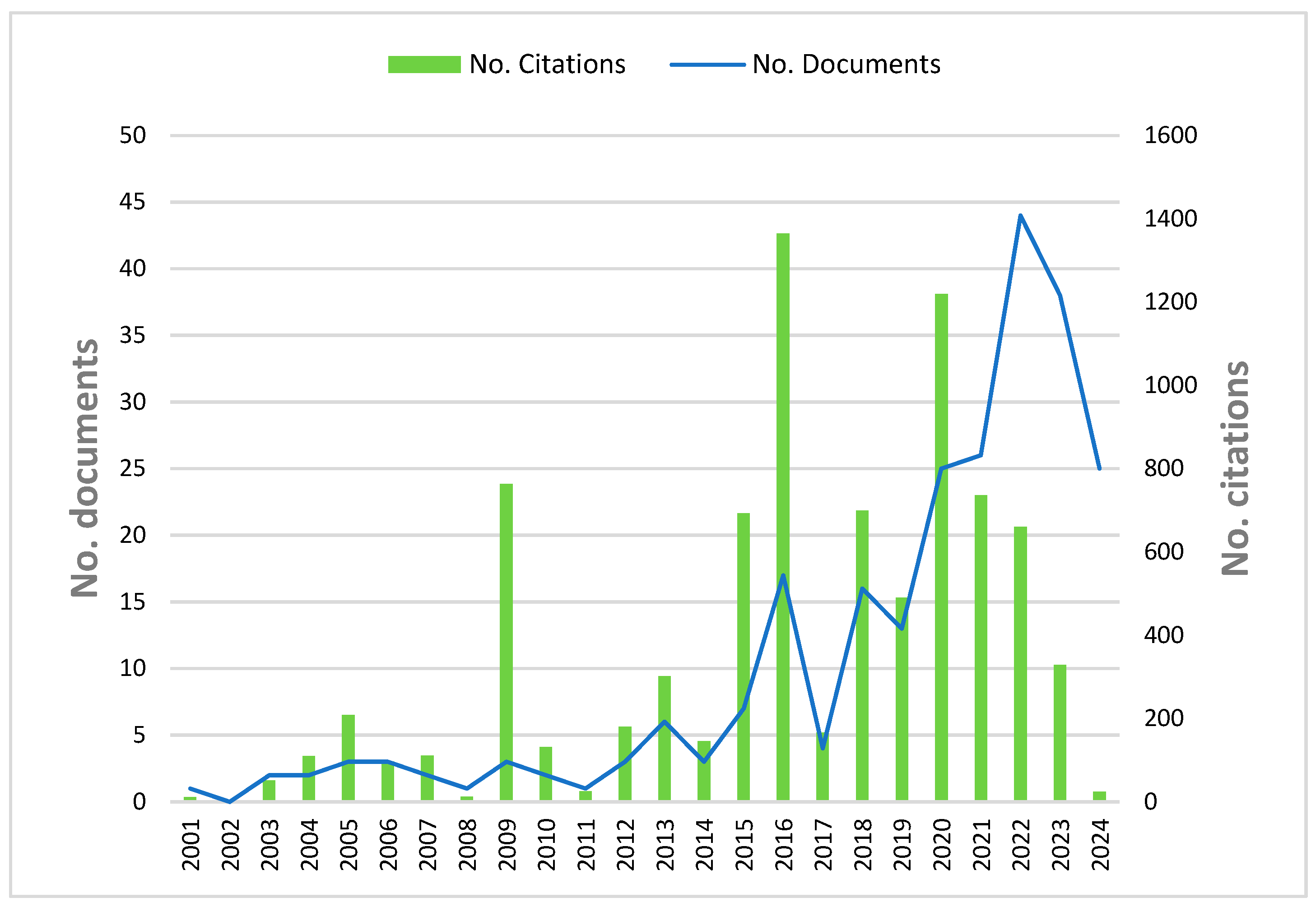
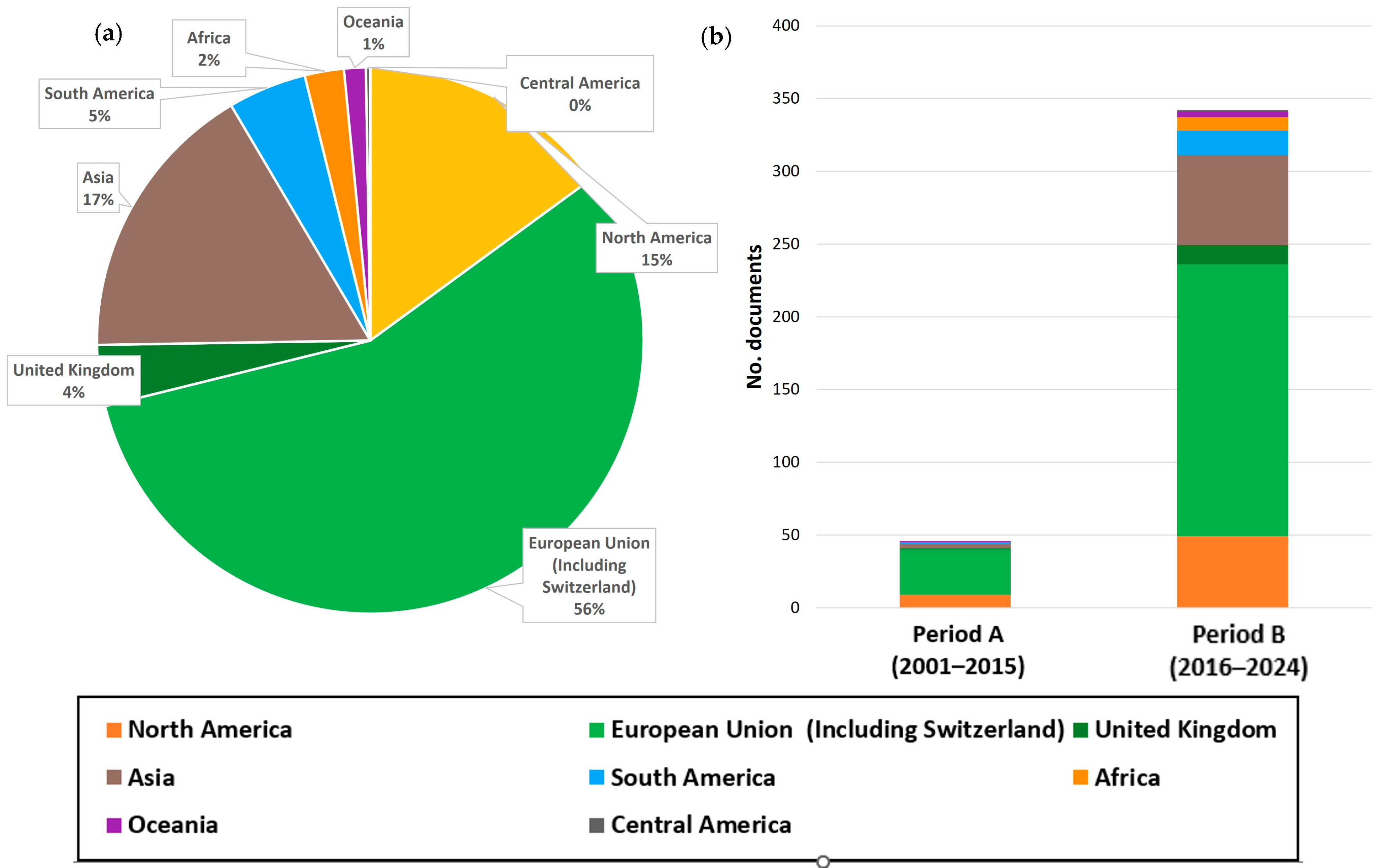
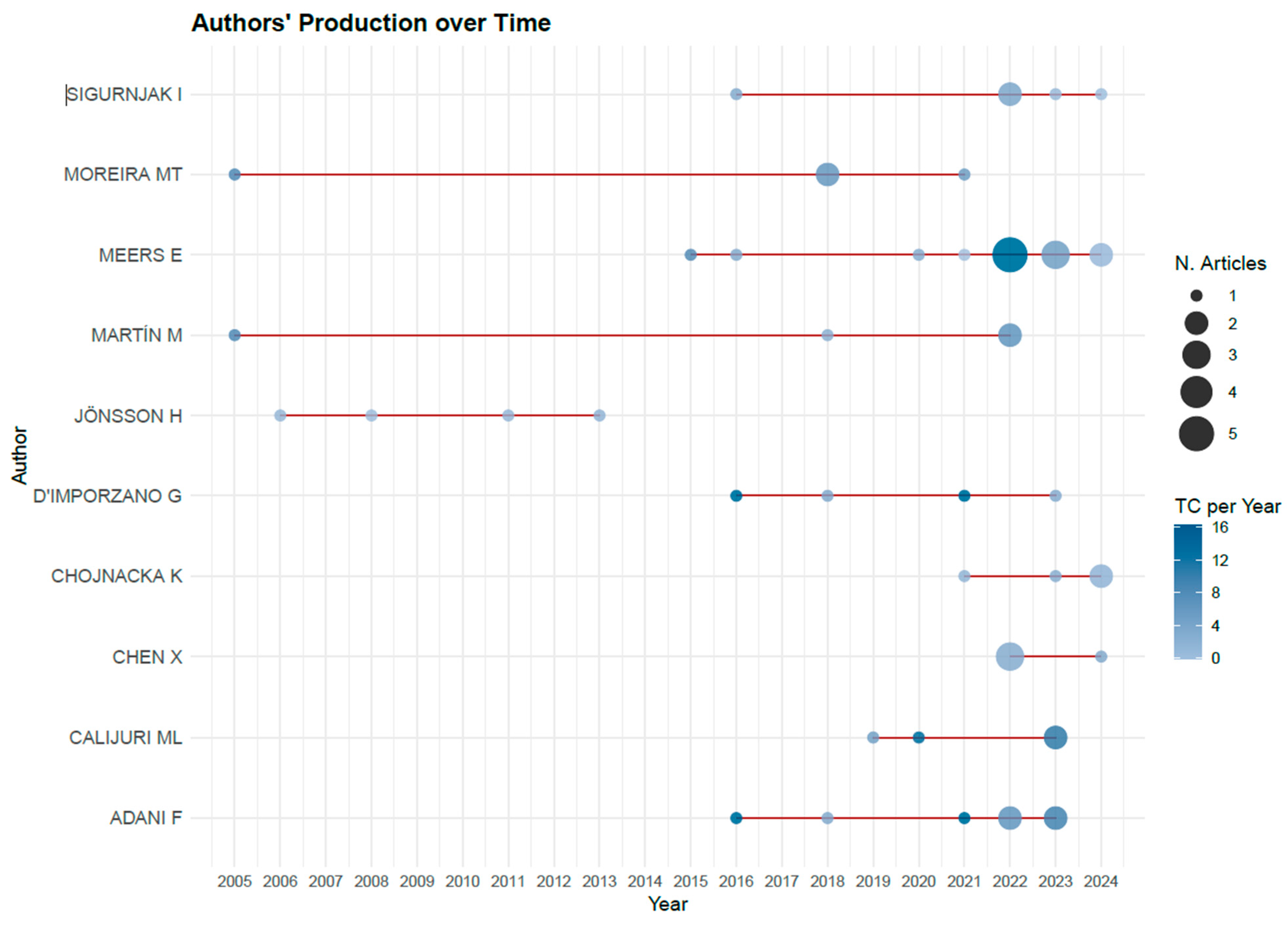
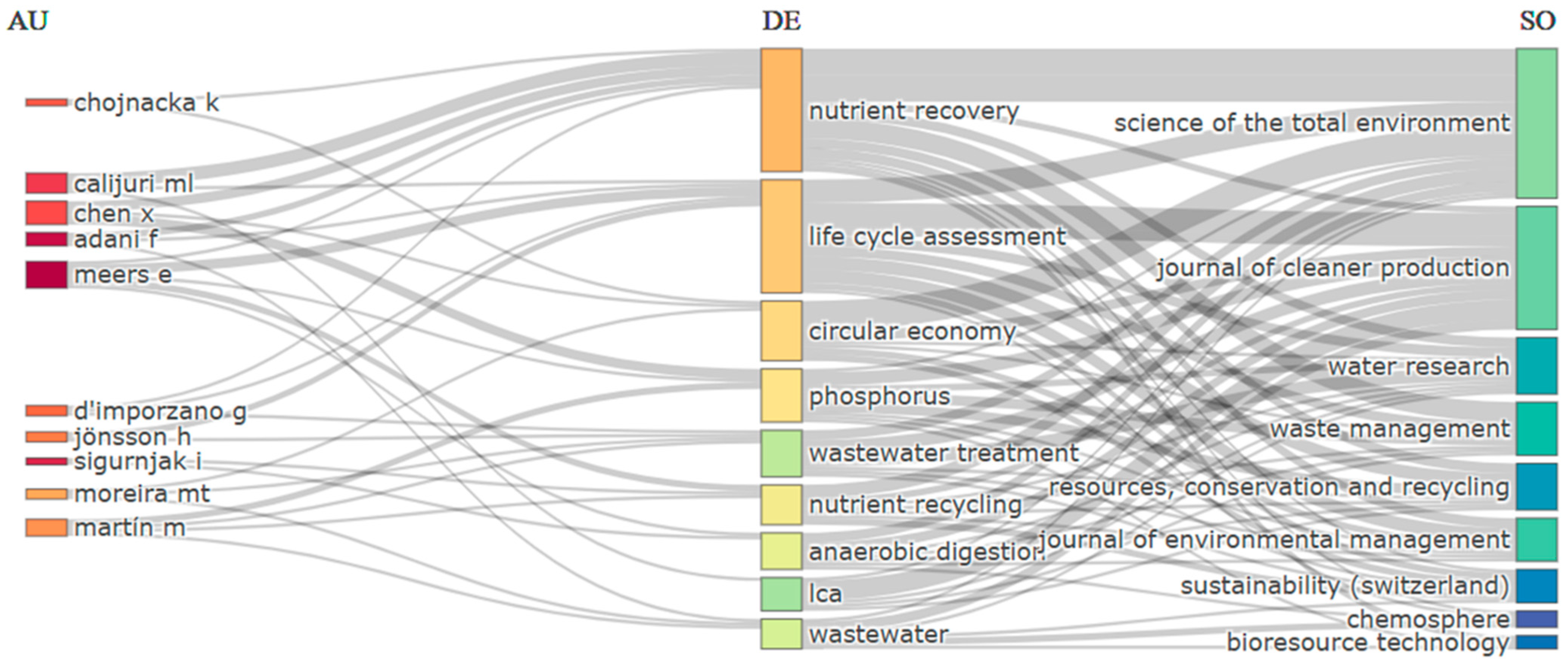
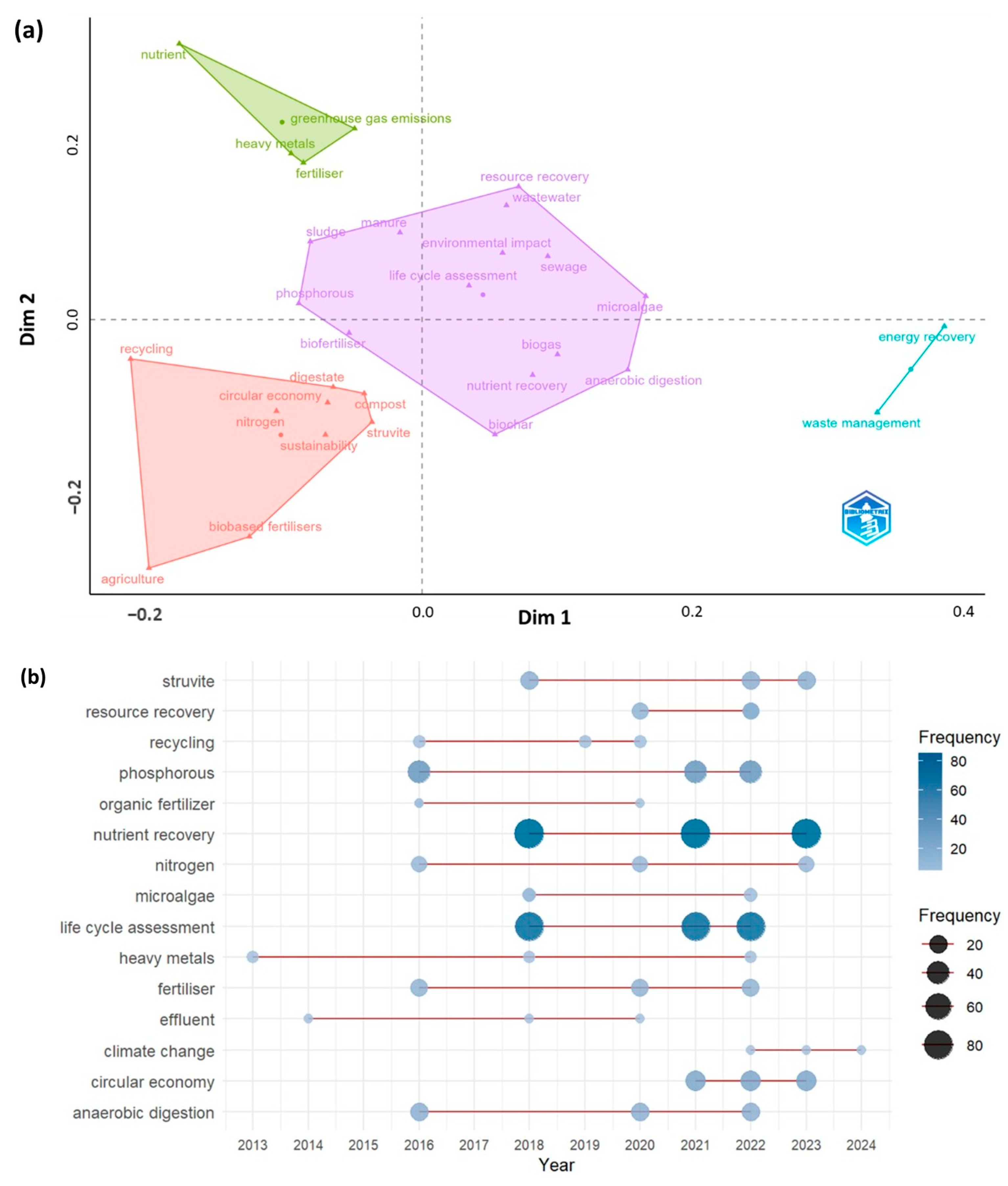
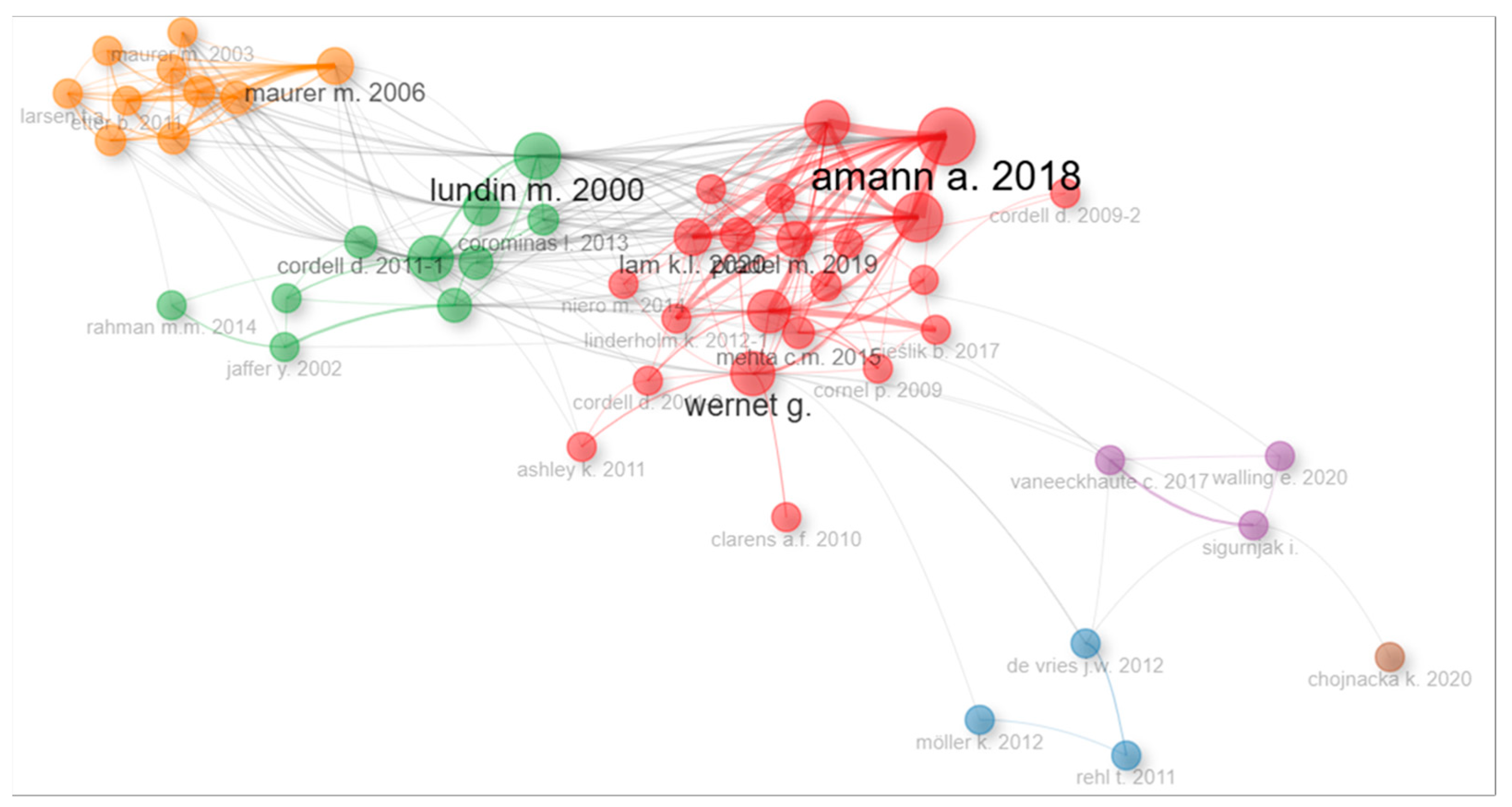
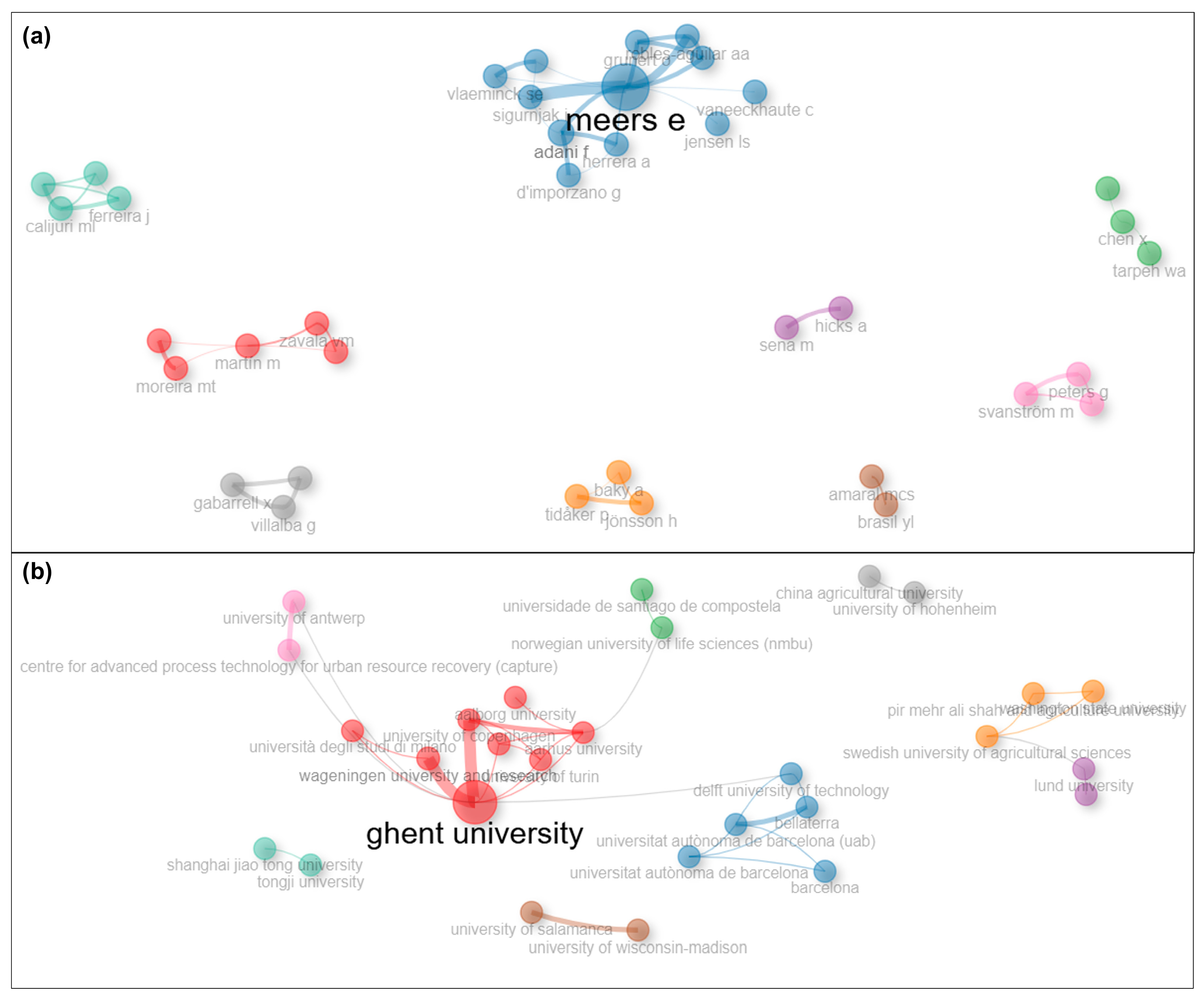
| Terms of BBFs | Terms of Environmental Impacts |
|---|---|
| OR (“bio-based fertili*”, “biobased fertili*”, “recycling derived fertili*”, “nutrient recovery”, “waste-based fetili*” “alternative fertili*”, “waste-to-fertili*”, “nutrient recycling”, “recycled fertili*”, “recovered nutrient”, “recover* nitrogen”, “recover* phosphorus”, “recover* carbon”, “fertili* product”, “fertili* products”) | OR (“environmental impact*”, “environmental assess*” “environmental indicator*”, “environmental analys*”, “environmental metric*”) |
| Sources | Publisher | No. Publications | H Index | Impact Factor | Cite Score | Quartile | Most Cited Rank |
|---|---|---|---|---|---|---|---|
| Science Of the Total Environment | Elsevier | 32 | 11 | 10.754 | 16.8 | Q1 | 4th |
| Journal Of Cleaner Production | Elsevier | 26 | 16 | 11.072 | 18.5 | Q1 | 3rd |
| Journal Of Environmental Management | Elsevier | 12 | 5 | 8.91 | 13.4 | Q1 | 11th |
| Waste Management | Elsevier | 10 | 7 | 8.816 | 15.1 | Q1 | 5th |
| Water Research | Elsevier | 10 | 8 | 13.4 | 19.8 | Q1 | 2nd |
| Resources, Conservation and Recycling | Elsevier | 9 | 6 | 13.716 | 20.3 | Q1 | 9th |
| Sustainability (Switzerland) | MDPI | 9 | 3 | 3.9 | 5.8 | Q1 | 14th |
| Bioresource Technology | Elsevier | 7 | 6 | 11.889 | 19 | Q1 | 1st |
| Chemosphere | Elsevier | 7 | 4 | 8.943 | 13.3 | Q1 | 7th |
| Environmental Science and Technology | ACS | 7 | 4 | 11.357 | 16.7 | Q1 | 6th |
Disclaimer/Publisher’s Note: The statements, opinions and data contained in all publications are solely those of the individual author(s) and contributor(s) and not of MDPI and/or the editor(s). MDPI and/or the editor(s) disclaim responsibility for any injury to people or property resulting from any ideas, methods, instructions or products referred to in the content. |
© 2025 by the authors. Licensee MDPI, Basel, Switzerland. This article is an open access article distributed under the terms and conditions of the Creative Commons Attribution (CC BY) license (https://creativecommons.org/licenses/by/4.0/).
Share and Cite
Torres-Guerrero, C.A.; Peña, N.; Colón, J.; Egas, D.; Robles-Aguilar, A.; Llenas, L.; Senán-Salinas, J. A Bibliometric Anatomy of Literature on Bio-Based Fertilisers with Insights into Environmental Impacts and Evaluation Approaches. Environments 2025, 12, 386. https://doi.org/10.3390/environments12100386
Torres-Guerrero CA, Peña N, Colón J, Egas D, Robles-Aguilar A, Llenas L, Senán-Salinas J. A Bibliometric Anatomy of Literature on Bio-Based Fertilisers with Insights into Environmental Impacts and Evaluation Approaches. Environments. 2025; 12(10):386. https://doi.org/10.3390/environments12100386
Chicago/Turabian StyleTorres-Guerrero, Carlos Alberto, Nancy Peña, Joan Colón, Daniel Egas, Ana Robles-Aguilar, Laia Llenas, and Jorge Senán-Salinas. 2025. "A Bibliometric Anatomy of Literature on Bio-Based Fertilisers with Insights into Environmental Impacts and Evaluation Approaches" Environments 12, no. 10: 386. https://doi.org/10.3390/environments12100386
APA StyleTorres-Guerrero, C. A., Peña, N., Colón, J., Egas, D., Robles-Aguilar, A., Llenas, L., & Senán-Salinas, J. (2025). A Bibliometric Anatomy of Literature on Bio-Based Fertilisers with Insights into Environmental Impacts and Evaluation Approaches. Environments, 12(10), 386. https://doi.org/10.3390/environments12100386







